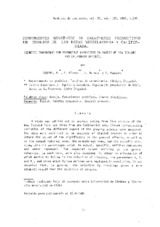Componentes genéticos de caracteres productivos en conejos de las razas neozelandesa y californiana
Genetic components for productive characters in rabbit of new zealand and California breeds
Autor
Alonso Moraga, F.
Madueño Rojas, R.
Morera Sanz, L.
Rodero Franganillo, Antonio
Editor
Universidad de Córdoba, Servicio de PublicacionesFecha
1986Materia
ConejosComponentes genéticos
Cruces dialélicos
Cunicultura
METS:
Mostrar el registro METSPREMIS:
Mostrar el registro PREMISMetadatos
Mostrar el registro completo del ítemResumen
A study was carried out on animals coming from five strains of the New Zealand Race and three from the Californiar one. Eleven corresponding variables of the different aspect of the growing animals were analysed. The data were submitted to an analysis of diallel crosses in order to obtain the values of the significance on the general effects, as well as on the mutual maternal ones, the nonmaternal ones, and the specific ones, along with the porcentages which the mutual, specific, additive components and error represent. The expected values arriving at the general heterosis, in each case, were also examined. To obtain an orientation of which method to follow in the selection of crossing, the parameters G, S, and V., and those which Curnow defines were employecLIn conclusion, it was observed that, in general, the selection by crossings gives a more adequate result than the selection by strains. Se ha trabajado con animales pertenecientes a cinco estirpes de la raza neozelandesa y tres de la raza californiana, sobre 11 variables correspondientes a diferentes aspectos del crecimiento animal. Los controles han sido sometidos a un análisis de cruces dialélicos, para obtener, en cada caso, los valores de significación de los efectos generales, recíprocos maternos, recíprocos no maternos y específicos, así como los porcentajes que representan los componentes recíprocos, específicos, aditivos y error. Se determinan también los valores esperados que alcanza la heterosis general, en cada uno de los casos. Para conseguir una orientación sobre el método a seguir en la selección de los cruces, hemos obtenido los parámetros G, S y Vi, tal como los define Curnow. En general, la selección por cruces resulta más apropiada que la selección por estirpes.

